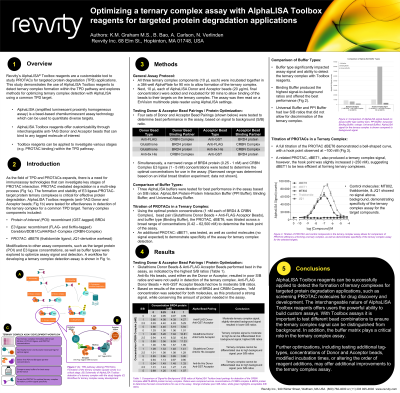Frontiers in Technology
Poster Session B
(1101-B) Ternary complex assays: Optimizing AlphaLISA Toolbox reagents for targeted protein degradation applications
Wednesday, May 29, 2024
10:30 - 11:15 CEST
Location: Exhibit Hall


Nico Verlinden
Portfolio Leader Immunoassay Reagents
Revvity
Lier, Antwerpen, Belgium
Poster Presenter(s)
Abstract: Harnessing the power of natural protein degradation pathways, targeted protein degradation (TPD), including development of proteolysis targeting chimeras (PROTACs), is a therapeutic strategy to circumvent drug resistance and target previously undruggable proteins. As the field expands, there is a need for technologies that can investigate key stages of PROTAC interaction, including the formation and stability of E3 ligase-PROTAC-target protein ternary complexes, which are critical for effective protein degradation. AlphaLISA® Toolbox reagents (Revvity, Inc., Waltham MA) meet this need by providing the flexibility to study variable ligases, protein targets, and PROTAC molecules in a convenient, no-wash, bead-based luminescent amplification immunoassay format. Toolbox reagents offer assay customization with interchangeable anti-TAG Donor and Acceptor beads that can bind to any tagged molecule of interest. This study demonstrates the use of AlphaLISA Toolbox reagents to detect ternary complex formation and explores methods for optimizing ternary complex detection with AlphaLISA using a common TPD target. The study PROTAC, dBET6, includes a thalidomide ligand for the E3 ligase: recombinant (FLAG- and 6xHIS-tagged) Cereblon/DDB1/Cul4A/Rbx1-Complex (CRBN-Complex), linked to a JQ1-derivative warhead for the target protein: recombinant (GST-tagged) BRD4. Using a simple protocol which incubates all components of the ternary complex together followed by simultaneous incubation with Toolbox Donor and Acceptor beads, formation of the ternary complex was detectable by AlphaLISA in just over three hours. To develop and refine the assay, we broadly titrated concentrations of BRD4, CRBN-Complex, and dBET6 along with various combinations of anti-TAG Donor and Acceptor beads, including anti-GST (or Glutathione), anti-FLAG, and anti-6xHis tag beads. Anti-6xHis beads showed limited success for ternary complex detection, however pairings of anti-GST or Glutathione beads with anti-FLAG tag beads performed well, with strong Alpha signal produced by the ternary complex compared to background signal, particularly for Glutathione Donor beads paired with anti-FLAG Acceptor beads. Signal-to-background ratio improved at relatively low concentrations of BRD4 protein (≤1 nM) and CRBN-Complex (≤2.5 nM). A comparison of assay buffers proved the buffer matrix to be an important component of the ternary complex assay. AlphaLISA Binding Assay Buffer produced better signal-to-background ratios compared to Protein-Protein Interaction Buffer, and particularly compared to Universal Assay Buffer, which did not support ternary complex formation. Finally, titration of the dBET6 PROTAC with the selected optimal 1 nM BRD4 and 1 nM CRBN-Complex concentrations, successfully established the hook point concentration of the assay (~100 nM), and demonstrated its efficacy compared to a related PROTAC, dBET1 (hook point: ~250 nM). Titrations of control compounds produced no signal, indicating specificity of the assay for ternary complex detection with the target molecules. Overall, this work highlights the utility of AlphaLISA Toolbox reagents as a customizable solution for studying ternary complex formation as part of PROTAC molecule screening.
